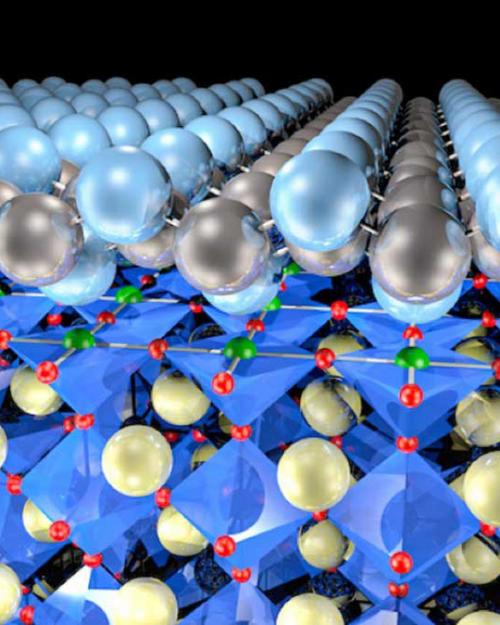Cornell researchers have discovered a rare “pseudogap” phenomenon that helps explain how the superconducting transition temperature can be greatly boosted in a single monolayer of iron selenide, and how it might be applied to other superconducting materials.
The group’s paper, “Incoherent Cooper Pairing and Pseudogap Behavior in Single-Layer FeSe/SrTiO3,” published June 10 in Physical Review X. The paper’s lead author is Brendan Faeth, Ph.D. ’20.
The team was led by Kyle Shen, the James A. Weeks Professor of Physical Sciences in the College of Arts and Sciences, who, together with Faeth, sought to explore the properties of monolayer iron selenide because, as a high-temperature superconductor, it has the potential to help researchers create novel electrical devices that conduct with zero resistance and, therefore, much greater efficiency.
One of the unusual traits of iron selenide is that, when it comes to conducting electricity, less is more. In bulk crystal form, the material becomes a superconductor at around 8 kelvin (or minus -445.27 degrees Fahrenheit). But when grown as a single monolayer atop a substrate of strontium titanate, the compound superconducts at a much higher temperature: between 30 to 60 kelvin (minus 405.67 to minus 351.67 degrees Fahrenheit).
“The magnitude of the enhancement is really big,” Shen said. “Usually making materials really thin makes superconductivity worse. This is the total opposite. But the mechanism by which this enhancement was occurring was basically not known.”
That mystery was compounded by mixed results from previous attempts to pinpoint the exact temperature of superconductivity in monolayer iron selenide.
“People were doing these different types of measurements, and some people were saying, ‘Oh, my Tc (transition temperature) is 20 kelvin or 30 kelvin,’ and other people would say, ‘No, my Tc is 60 kelvin,’” Shen said. “So it wasn’t really understood why people were reporting these Tc’s that are completely all over the map. In doing our experiments, we see, ‘Oh, actually, you’re kind of both right.’”
One reason this phenomenon has been difficult to study is that iron selenide in its monolayer form – which the researchers grow via molecular beam epitaxy – is incredibly fragile. If the material is removed from the ultra-high vacuum inside the growth chamber, the air will attack and disintegrate it. While scientists have been able to make partial measurements, no one has been able to piece together a complete and coherent picture of why the superconducting transition temperature in monolayer iron selenide is so much higher than in its bulk form, a situation that Shen compares to the parable about the blind men attempting to describe an elephant.
So Shen’s team got creative. Faeth, currently a research associate at Cornell’s Platform for the Accelerated Realization, Analysis and Discovery of Interface Materials (PARADIM), custom-built an elaborate system of ultra-high vacuum chambers docked together around a growth chamber. The system enabled the team to conduct a battery of measurements on monolayer iron selenide samples without removing or disturbing them.
“It’s like a space station in reverse, because the vacuum is on the inside,” Shen said. “We were able to do a whole sequence of different measurements. And in doing so, we were able to observe this so-called pseudogap phase, which had never been reported before in this system. That’s sort of a hallmark of unconventional high-temperature superconductivity, also seen in the high-Tc cuprate superconductors. And it gives us some clues as to what might be the mechanism for this enhanced pairing temperature.”
For a material to enter the superconducting state with zero resistance, two things must happen: the electrons need to form so-called Cooper pairs and then the quantum-mechanical “phase” of all those pairs must become uniform. In typical superconductors, those two things usually occur simultaneously. However, in some exotic high-temperature superconductors there is a lag between the two steps.
Faeth’s measurements determined that an “unprecedentedly large” pseudogap begins around 60 kelvin, when incoherent Cooper pairs begin to form. However, the pairs don’t actually form a genuine superconducting condensate until about 30 kelvin.
Now that the researchers have a clearer understanding of that mechanism, they can try to enhance the effect by changing the parameters of the substrate, or possibly employ it in other superconductors to boost their performance.
“People have been working for 100 years to make high-temperature superconductors,” Shen said. “If you could actually do that, it would be revolutionary for energy transport, quantum information processing, electronics and any number of very important applications.”
Co-authors include Darrell Schlom, the Herbert Fisk Johnson Professor of Industrial Chemistry; former Kavli Institute at Cornell for Nanoscale Science postdoctoral fellows Shuolong Yang and Jason Kawasaki; and doctoral students Jocienne Nelson and Chris Parzyck.
The research was primarily supported through the Air Force Office of Scientific Research, as well as the National Science Foundation and the Gordon and Betty Moore Foundation. The researchers also made use of the Cornell Center for Materials Research, which is supported by the NSF’s Materials Research Science and Engineering Center program, and the Cornell NanoScale Science and Technology Facility, also supported by the NSF.
Read the story in the Cornell Chronicle.




